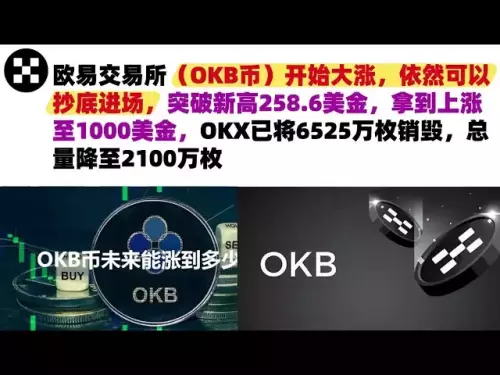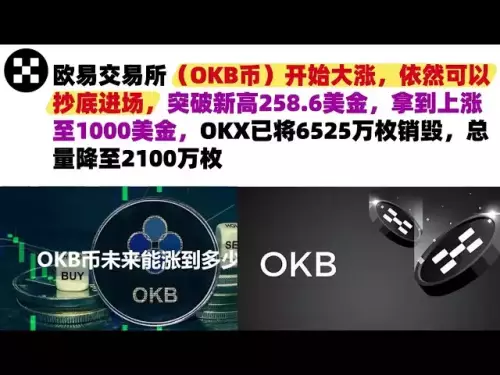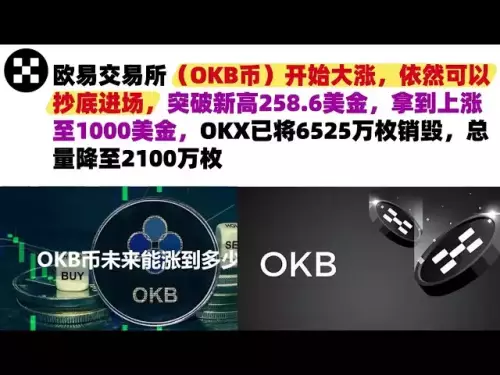-
 Bitcoin
Bitcoin $108600
-1.98% -
 Ethereum
Ethereum $4363
-1.06% -
 Tether USDt
Tether USDt $1.000
0.00% -
 XRP
XRP $2.792
-3.30% -
 BNB
BNB $854.8
-0.96% -
 Solana
Solana $200.6
-5.21% -
 USDC
USDC $0.9998
0.00% -
 Dogecoin
Dogecoin $0.2145
-2.01% -
 TRON
TRON $0.3387
-0.31% -
 Cardano
Cardano $0.8129
-3.32% -
 Chainlink
Chainlink $23.15
-2.64% -
 Hyperliquid
Hyperliquid $43.46
-3.79% -
 Ethena USDe
Ethena USDe $1.000
0.00% -
 Sui
Sui $3.289
-2.32% -
 Stellar
Stellar $0.3542
-2.67% -
 Bitcoin Cash
Bitcoin Cash $533.9
-0.92% -
 Cronos
Cronos $0.3090
1.58% -
 Avalanche
Avalanche $23.59
-2.33% -
 Hedera
Hedera $0.2236
-3.17% -
 UNUS SED LEO
UNUS SED LEO $9.507
0.87% -
 Litecoin
Litecoin $109.9
-0.98% -
 Toncoin
Toncoin $3.076
-0.21% -
 Shiba Inu
Shiba Inu $0.00001232
0.09% -
 Uniswap
Uniswap $9.700
-0.28% -
 Polkadot
Polkadot $3.766
-2.42% -
 Dai
Dai $0.0000
-0.01% -
 Bitget Token
Bitget Token $4.529
-1.25% -
 Monero
Monero $263.0
0.48% -
 Aave
Aave $316.0
0.95% -
 Ethena
Ethena $0.6607
-0.48%
What is a good RSI level to buy Dogecoin?
An RSI between 20 and 30, especially with rising volume and positive news, is a strong buy signal for Dogecoin, indicating potential reversal from oversold levels.
Aug 28, 2025 at 02:29 pm

Understanding RSI in Cryptocurrency Trading
1. The Relative Strength Index (RSI) is a momentum oscillator widely used in technical analysis to measure the speed and change of price movements. It operates on a scale from 0 to 100 and helps traders identify overbought or oversold conditions in an asset. In the volatile world of cryptocurrencies like Dogecoin, RSI serves as a valuable tool for timing entries and exits.
2. When the RSI falls below 30, the asset is typically considered oversold, indicating a potential reversal to the upside. Conversely, an RSI above 70 suggests the asset may be overbought, signaling a possible pullback. These thresholds are not absolute, especially in strong trending markets where assets can remain overbought or oversold for extended periods.
3. For Dogecoin, which often experiences sharp rallies and sudden corrections due to its meme-driven nature and high retail participation, RSI readings need to be interpreted within the context of broader market sentiment and volume trends. Relying solely on RSI without considering other indicators or news events can lead to misleading signals.
4. Traders often use a modified RSI approach for cryptocurrencies, adjusting the standard thresholds. Some prefer using 25 as the oversold level and 75 as overbought to account for the persistent bullish momentum seen in assets like Dogecoin during hype cycles.
5. It is also common to apply a 14-period RSI on daily or 4-hour charts when analyzing Dogecoin, as these timeframes balance responsiveness with reliability. Shorter timeframes can generate excessive noise, while longer ones may delay actionable signals.
Optimal RSI Levels for Buying Dogecoin
1. A widely accepted strategy is to consider buying Dogecoin when its RSI drops to 30 or below, particularly if the price is holding above a key support level. This combination increases the probability of a bounce, especially after a sharp correction driven by profit-taking or negative sentiment.
2. An RSI reading between 20 and 30 is often seen as a stronger buy signal for Dogecoin, especially when accompanied by increasing trading volume and positive developments such as exchange listings, social media buzz, or endorsements from influential figures.
3. Divergence patterns can enhance the reliability of RSI signals. For example, if Dogecoin’s price makes a lower low but the RSI forms a higher low, it indicates weakening downward momentum and a potential upward reversal, making it a favorable entry point.
4. Some traders wait for the RSI to cross back above 30 from below as confirmation of momentum shift. This lagging confirmation helps avoid entering too early during continued downtrends, particularly in bearish macroeconomic conditions.
5. During strong bull runs, Dogecoin’s RSI may rarely dip below 40, suggesting that waiting for a 30 reading could cause missed opportunities. In such cases, traders monitor for RSI pullbacks to the 35–40 range as potential re-entry zones, especially on higher timeframes.
Combining RSI with Other Indicators
1. RSI should not be used in isolation. Pairing it with moving averages, such as the 50-day or 200-day MA, helps confirm trend direction. A buy signal is stronger when RSI exits oversold territory and the price is above a key moving average.
2. Volume analysis is crucial. A drop in RSI to oversold levels on low volume may indicate weak selling pressure, whereas a spike in volume during the RSI recovery suggests strong buyer interest and a higher chance of sustained upward movement.
3. Support and resistance levels add context. If Dogecoin reaches an established support zone while RSI is below 30, the confluence of technical factors increases the likelihood of a rebound.
4. The MACD (Moving Average Convergence Divergence) can confirm RSI signals. A bullish MACD crossover occurring at the same time as RSI rising from oversold levels strengthens the case for a long position.
5. On-chain metrics, such as exchange outflows or rising active addresses, can provide fundamental backing to RSI-based trading decisions, especially in a market where sentiment shifts rapidly.
Frequently Asked Questions
What does an RSI below 20 mean for Dogecoin?An RSI below 20 indicates extreme oversold conditions, often seen after sharp sell-offs. While it suggests a potential reversal, it doesn’t guarantee an immediate bounce. In strong downtrends, RSI can remain low for extended periods. Traders watch for volume spikes or positive news to confirm a turnaround.
Can RSI predict Dogecoin’s price accurately?RSI does not predict price but measures momentum and potential reversal zones. It works best when combined with price action, volume, and broader market analysis. Relying solely on RSI can lead to false signals, especially during periods of low liquidity or high volatility.
Is a 70 RSI always a sell signal for Dogecoin?Not necessarily. During strong bullish phases, Dogecoin can maintain an RSI above 70 for days or weeks. In such cases, an RSI above 70 reflects strong buying pressure rather than an imminent reversal. Traders often wait for a drop below 70 or bearish divergence before considering exits.
How often should I check Dogecoin’s RSI?The frequency depends on your trading strategy. Day traders may monitor RSI on 15-minute or hourly charts multiple times a day. Swing traders typically review daily RSI readings once or twice daily. Over-checking can lead to emotional decisions, especially during volatile swings.
Disclaimer:info@kdj.com
The information provided is not trading advice. kdj.com does not assume any responsibility for any investments made based on the information provided in this article. Cryptocurrencies are highly volatile and it is highly recommended that you invest with caution after thorough research!
If you believe that the content used on this website infringes your copyright, please contact us immediately (info@kdj.com) and we will delete it promptly.
- AAVE Price Prediction: Will It Breakout to $400 by September 2025?
- 2025-08-30 19:25:13
- Bitcoin, Ethereum, XRP Price Check: What's the Deal?
- 2025-08-30 19:05:16
- AI Coins in 2025: Riding the $LYNO Wave in the Cryptocurrency World
- 2025-08-30 19:45:13
- BlockchainFX, MAGACOIN FINANCE, Crypto Presale: The 2025 Hot List
- 2025-08-30 19:50:12
- Navigating the Crypto Treasury Landscape: Investor Knowledge and Trend Analysis
- 2025-08-30 20:05:17
- Trump, Rumors, and X (Twitter): A New York Minute on Crypto Chaos
- 2025-08-30 20:10:12
Related knowledge
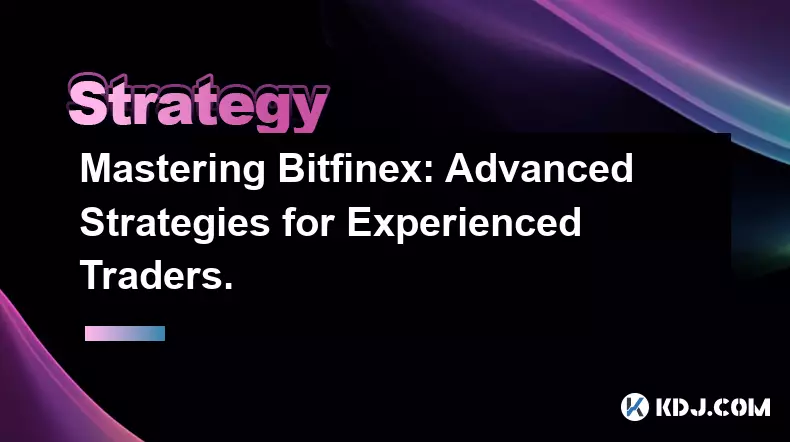
Mastering Bitfinex: Advanced Strategies for Experienced Traders.
Aug 30,2025 at 01:54am
Optimizing Order Types for Maximum Efficiency1. Utilizing limit orders allows traders to set precise entry and exit points, ensuring control over trad...
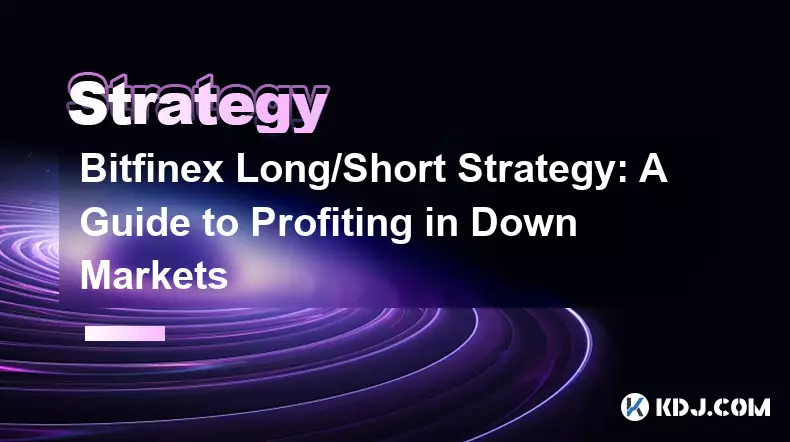
Bitfinex Long/Short Strategy: A Guide to Profiting in Down Markets
Aug 30,2025 at 09:55am
Understanding the Bitfinex Long/Short Ratio1. The Bitfinex long/short ratio reflects the proportion of long positions to short positions held by trade...

What is a good RSI level to buy Dogecoin?
Aug 28,2025 at 02:29pm
Understanding RSI in Cryptocurrency Trading1. The Relative Strength Index (RSI) is a momentum oscillator widely used in technical analysis to measure ...

How to use Bollinger Bands for Dogecoin trading?
Aug 30,2025 at 01:37am
Understanding Bollinger Bands in Dogecoin Trading1. Bollinger Bands consist of three lines plotted on a price chart: the middle band, which is a simpl...
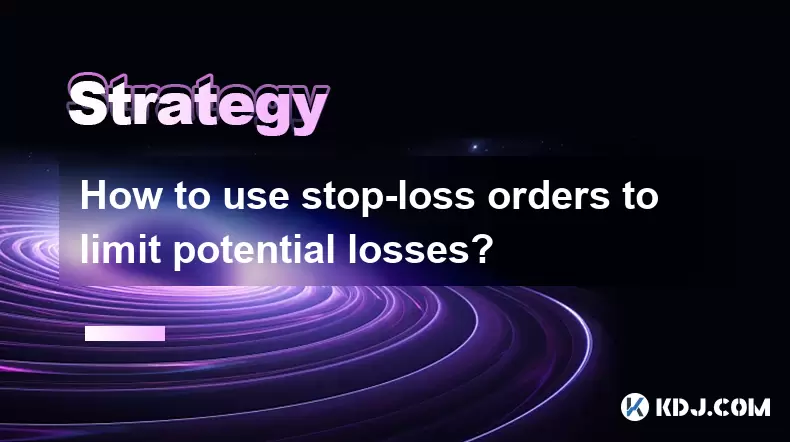
How to use stop-loss orders to limit potential losses?
Aug 08,2025 at 02:01pm
Understanding Stop-Loss Orders in Cryptocurrency TradingA stop-loss order is a risk management tool used by traders to automatically sell a cryptocurr...
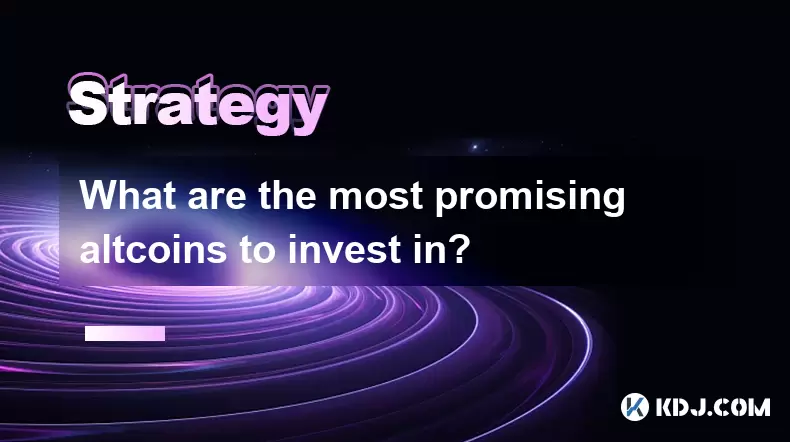
What are the most promising altcoins to invest in?
Aug 10,2025 at 11:42am
Understanding the Role of Private Keys in Cryptocurrency WalletsIn the world of cryptocurrency, private keys are the cornerstone of ownership and cont...

Mastering Bitfinex: Advanced Strategies for Experienced Traders.
Aug 30,2025 at 01:54am
Optimizing Order Types for Maximum Efficiency1. Utilizing limit orders allows traders to set precise entry and exit points, ensuring control over trad...

Bitfinex Long/Short Strategy: A Guide to Profiting in Down Markets
Aug 30,2025 at 09:55am
Understanding the Bitfinex Long/Short Ratio1. The Bitfinex long/short ratio reflects the proportion of long positions to short positions held by trade...

What is a good RSI level to buy Dogecoin?
Aug 28,2025 at 02:29pm
Understanding RSI in Cryptocurrency Trading1. The Relative Strength Index (RSI) is a momentum oscillator widely used in technical analysis to measure ...

How to use Bollinger Bands for Dogecoin trading?
Aug 30,2025 at 01:37am
Understanding Bollinger Bands in Dogecoin Trading1. Bollinger Bands consist of three lines plotted on a price chart: the middle band, which is a simpl...

How to use stop-loss orders to limit potential losses?
Aug 08,2025 at 02:01pm
Understanding Stop-Loss Orders in Cryptocurrency TradingA stop-loss order is a risk management tool used by traders to automatically sell a cryptocurr...

What are the most promising altcoins to invest in?
Aug 10,2025 at 11:42am
Understanding the Role of Private Keys in Cryptocurrency WalletsIn the world of cryptocurrency, private keys are the cornerstone of ownership and cont...
See all articles























